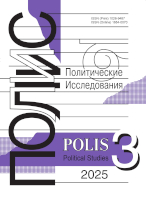The second Karabakh war:
background, causes, consequences
Lantzov S.A.,
Saint Petersburg State University, Saint Petersburg, Russia, s_lantsov@mail.ru
elibrary_id: 364735 | ORCID: 0000-0001-8428-7755 | RESEARCHER_ID: G-4678-2015
DOI: 10.17976/jpps/2022.03.08
Lantzov S.A. The second Karabakh war: background, causes, consequences. – Polis. Political Studies. 2022. No. 3. https://doi.org/10.17976/jpps/2022.03.08
The article analyzes the preconditions, causes and consequences of the resumption of hostilities in the zone of the Nagorno-Karabakh conflict in the fall of 2020. The structure of the Nagorno-Karabakh conflict and the stages of its development in the late XX – early XXI centuries are considered. The paper considers the activities of the OSCE Minsk Group and its efforts for the peaceful settlement of the Nagorno-Karabakh conflict. The danger of the existence of unresolved, “frozen” conflicts is conditioned by the potential for a renewed armed confrontation. The reasons for the resumption of hostilities in Nagorno-Karabakh are analyzed at three levels in accordance from a neorealist perspective. At the level of interpersonal relations, the regress in mutual understanding between the leaders of Armenia and Azerbaijan, which has manifested itself in recent years, is analysed. Their careers and political experience are compared. At the level of analysis of interstate relations between Armenia and Azerbaijan, a comparative characteristic of the potential of these states is presented. From the very beginning the conflict over Nagorno-Karabakh was asymmetric but a gradual change in the balance of military power in favor of the Azerbaijani side is perceptible. When analyzing the internal political processes, attention is drawn to a weakening of state institutions in Armenia after the events of 2018. At all stages of the Nagorno-Karabakh conflict, the influence of nationalism on the mass consciousness of the population of Armenia and Azerbaijan remained, which impacted the policies of both parties involved in the conflict. Analyzing the processes taking place at the level of the system of international relations, the author notes the growing activity of Turkey, striving for leadership and hegemony in the region. There is a significant increase in the level of political and military support to Azerbaijan from this country. The article emphasizes the role of the Russian Federation as an effective mediator that managed to broker an agreement between the two sides to end the armed struggle in Nagorno-Karabakh. The deal reached on November 9, 2020 is analysed as well as the consequences for Russia’s foreign policy of “unfreezing” the conflict.
References
Brown, S. (1994). The causes and prevention of war. New York, NY: St. Martin’s Press.
Hopmann, P.T. (2015). Minsk group mediation of the Nagorno-Karabakh conflict: confronting an “intractable conflict”. OSCE Yearbook. Baden-Baden. P. 167-179.
Mitchell, C.R. (1989). The structure of international conflict. London: Macmillan.
Paul, T.V. (1994). Asymmetric conflicts. War initiation by weaker powers. Cambridge, NY: Cambridge University Press.
Snyder, J. (1993). Nationalism and the crisis of the post-Soviet state. Survival, 35(1), 5-26. https://doi.org/10.1080/00396339308442671
Waltz, K. (1959). Man, the state and war: a theoretical analysis. New York, NY: Columbia University Press.
Waltz, K. (1979). Theory of international politics. Berkeley, CA: University of California; Addison- Wesley Publishing Company.
Waltz, K. (1994). The origins of war in neorealist theory. In R.K. Betts. Conflict after the Cold War (pp. 88-95). Boston: Allyn and Bacon.
Arbatova, N. (2019). Three dimensions of the post-Soviet “frozen” conflicts. World Economy and International Relations, 63(5), 88-100. (In Russ.) https://doi.org/10.20542/0131-2227-2019-63-5-88-100
Atanesyan, A.V. (2018). “Velvet revolution” in Armenia: potential, achievements and risks of political protest activity. Polis. Political Studies, 6, 80-98. (In Russ.) https://doi.org/10.17976/jpps/2018/06/06
Avetisyan, R.S., & Lantsov, S.A. (2011). Evolution of the structure of international conflict: case-study of Mountain Karabakh. Vestnik SPbSU. Series 6. Philosophy. Culturology. Political Science. Law. International Relations, 2, 90-96. (In Russ.)
Babayan, K.K. (2014). Madrid principles of Nagorno-Karabakh settlement. Vestnik RUDN. International Relations, 2, 121-129. (In Russ.)
Baranov, M., & Pukhov, R. (2020). The second Karabakh: interim results. Independent Military Review, 38, 1, 3. (In Russ.)
Baranovsky, V. (2019). New international order: overcoming or transforming the existing pattern? World Economy and International Relations, 63(5), 7-23. (In Russ.) https://doi.org/10.20542/0131-2227-2019-63-5-7-23
Deriglazova, L. (2009). Asimmetrichnye konflikty: Uravnenie so mnogimi neizvestnymi [Asymmetric conflicts: an equation with many unknowns]. Tomsk: Tomsk University Publ. (In Russ.)
Deriglazova, L., & Minasyan, S. (2011). Nagornyj Karabakh: paradoksy sily i slabosti v asimmetrichnom konflikte [Nagorno-Karabakh: paradoxes of strength and weakness in an asymmetric conflict]. Analiticheskie doklady Instituta Kavkaza [Analytical reports of the Caucasus Institute], 3. Erevan: Institut Kavkaza. (In Russ.)
Fedulova, N. (2010). Conflictogenic zones of near abroad: threat to Russia’s interests. World Economy and International Relations, 2, 75-89. (In Russ.)
Gromyko, A.A. (2020). The pandemic and the crisis in the system of international relations. Outlines of Global Transformations: Politics, Economics, Law, 13(5), 6-19. (In Russ.) https://doi.org/10.23932/2542-0240-2020-13-5-1
Majendorfskaya deklaraciya 2 noyabrya 2008 goda i situaciya vokrug Nagornogo Karabakha. (2009). [Mayendorf declaration on November 2, 2008 and the situation around Nagorno-Karabakh]. Moscow: Russkaya panorama. (In Russ.)
Markedonov, S.M. (2018). The thirty years of the Nagorno-Karabakh conflict: basic stages and prospects of the resolution. Post-Soviet Studies, 1(2), 129-139. (In Russ.)
Pyadyshev, B. (2009). The Karabakh history of the plenipotentiary representative of the president of Russia. International Affairs, 7, 6-35. (In Russ.)
Stepanova, E. (2020). Armed conf licts in the early 21st century: typology and directions of transformation. World Economy and International Relations, 64(6), 24-39. (In Russ.) https://doi.org/10.20542/0131-2227-2019-63-5-24-39
See also:
Gadzhiev K.S.,
Russian Federation: National State or a State of Nations?. – Polis. Political Studies. 2018. No3
Lebedeva Ye.B., Busygina I.M.,
Administrative-territorial division in Russian Federation: reforms and the factor of political regime. – Polis. Political Studies. 2012. No3
Zakharov A.A.,
Federal State and Separatism: Canadian Case. – Polis. Political Studies. 2002. No3
Rozov N.S.,
Crisis and Revolutions: Fields of Interaction, Actors’ Strategies, and Trajectories of Conflict Dynamics. – Polis. Political Studies. 2017. No6
Gasparian A.,
Armenia - Russia: A Stable Course of Strategic Partnership. – Polis. Political Studies. 1998. No6





.jpg)






 print
print
.jpg)
.jpg)